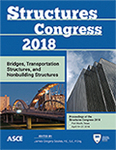Structures Congress 2018
The Dynamics of Precast Post-Tensioned Rocking Columns
Publication: Structures Congress 2018: Bridges, Transportation Structures, and Nonbuilding Structures
ABSTRACT
Precast post-tensioned column is a novel structural system that can be used as bridge piers. In such a system, the column does not have a moment connection with the foundation, therefore the rocking mechanism combining with post-tensioned force provides excellent deformation and re-centering capacity. The columns can be comprised of multiple segments or a single segment. This study examines the dynamic behaviors of post-tensioned columns under seismic excitations. The equations of motion are developed using Lagrange’s method and solved using fourth-order Runge-Kutta method. The effects of impacts, tendon stiffness, initial post-tensioning force, and characteristic of applied loadings on the dynamic behaviors are investigated. Results show that the vibration period increases with the increases in rotational amplitude. The increase in the tendon stiffness increases vibration frequency. Under sine and cosine pulse with the same amplitude and period, the rocking responses are different in terms of rocking amplitude. The use of post-tensioning tendons can help to reduce rotational amplitude and delay the initiation of rocking.
Get full access to this article
View all available purchase options and get full access to this chapter.
5. ACKNOWLEDGEMENTS
The financial contributions of Canadian Precast Prestressed Concrete Institute Graduate Scholarship and The Natural Sciences and Engineering Research Council (NSERC) of Canada through Discovery Grant were critical to conduct this study and are gratefully acknowledged.
6. REFERENCE
Andreaus, Ugo, & Casini, Paolo. (1999). Dynamics of three-block assemblies with unilateral deformable contacts. Part 2: actual application. Earthquake engineering & structural dynamics, 28(12), 1637–1649.
Aslam, Mohammad, Scalise, D Theodore, & Godden, William G. (1980). Earthquake rocking response of rigid bodies. Journal of the Structural Division, 106(2), 377–392.
Barthes, Clement Benjamin. (2012). Design of earthquake resistant bridges using rocking columns: University of California, Berkeley.
Caltrans. (2015). BRIDGE DESIGN PRACTICE: California Department of Transportation.
CSA. (2014). Canadian highway bridge design code: Canadian Standards Association.
Dawood, Haitham, Elgawady, Mohamed, & Hewes, Joshua. (2014). Factors affecting the seismic behavior of segmental precast bridge columns. Frontiers of Structural and Civil Engineering, 8(4), 388–398.
DeJong, Matthew J, & Dimitrakopoulos, Elias G. (2014). Dynamically equivalent rocking structures. Earthquake engineering & structural dynamics, 43(10), 1543–1563.
ElGawady, Mohamed A, & Sha’lan, Ahmad. (2010). Seismic behavior of self-centering precast segmental bridge bents. Journal of Bridge Engineering, 16(3), 328–339.
Hewes, Joshua T, & Priestley, MJ Nigel. (2002). Seismic design and performance of precast concrete segmental bridge columns.
Hogan, SJ. (1990). The many steady state responses of a rigid block under harmonic forcing. Earthquake Engineering & Structural Dynamics, 19(7), 1057–1071.
Housner, George W. (1963). The behavior of inverted pendulum structures during earthquakes. Bulletin of the seismological society of America, 53(2), 403–417.
Ishiyama, Yuji. (1982). Motions of rigid bodies and criteria for overturning by earthquake excitations. Earthquake Engineering & Structural Dynamics, 10(5), 635–650.
Makris, Nicos, & Konstantinidis, Dimitrios. (2003). The rocking spectrum and the limitations of practical design methodologies. Earthquake engineering & structural dynamics, 32(2), 265–289.
Ou, Yu-Chen, Tsai, Mu-Sen, Chang, Kuo-Chun, & Lee, George C. (2010). Cyclic behavior of precast segmental concrete bridge columns with high performance or conventional steel reinforcing bars as energy dissipation bars. Earthquake Engineering & Structural Dynamics, 39(11), 1181–1198.
Psycharis, Ioannis N. (1990). Dynamic behaviour of rocking two-block assemblies. Earthquake Engineering & Structural Dynamics, 19(4), 555–575.
Psycharis, Ioannis N, & Jennings, Paul C. (1983). Rocking of slender rigid bodies allowed to uplift. Earthquake Engineering & Structural Dynamics, 11(1), 57–76.
Scalia, Antonio, & Sumbatyan, Mezhlum A. (1996). Slide rotation of rigid bodies subjected to a horizontal ground motion. Earthquake engineering & structural dynamics, 25(10), 1139–1149.
Shenton, Harry W. III (1996). Criteria for initiation of slide, rock, and slide-rock rigid-body modes. Journal of Engineering Mechanics, 122(7), 690–693.
Sideris, Petros, Aref, Amjad J, & Filiatrault, Andre. (2014). Quasi-static cyclic testing of a large-scale hybrid sliding-rocking segmental column with slip-dominant joints. Journal of Bridge Engineering, 19(10), 04014036.
Spanos, Pol D, & Koh, Aik-Siong. (1984). Rocking of rigid blocks due to harmonic shaking. Journal of Engineering Mechanics, 110(11), 1627–1642.
Spanos, Pol D, Roussis, Panayiotis C, & Politis, Nikolaos PA. (2001). Dynamic analysis of stacked rigid blocks. Soil Dynamics and Earthquake Engineering, 21(7), 559–578.
Vassiliou, Michalis F, & Makris, Nicos. (2015). Dynamics of the vertically restrained rocking column. Journal of Engineering Mechanics, 141(12), 04015049.
Winkler, Tibor, Meguro, Kimiro, & Yamazaki, Fumio. (1995). Response of rigid body assemblies to dynamic excitation. Earthquake Engineering and Structural Dynamics, 24(10), 1389–1408.
Yim, Chik-Sing, Chopra, Anil K, & Penzien, Joseph. (1980). Rocking response of rigid blocks to earthquakes. Earthquake Engineering & Structural Dynamics, 8(6), 565–587.
Zhang, Jian, & Makris, Nicos. (2001). Rocking response of free-standing blocks under cycloidal pulses. Journal of Engineering Mechanics, 127(5), 473–483.
Zhang, Qi, & Alam, M Shahria. (2015). Evaluating the Seismic Behavior of Segmental Unbounded Posttensioned Concrete Bridge Piers Using Factorial Analysis. Journal of Bridge Engineering, 21(4), 04015073.
Information & Authors
Information
Published In
Structures Congress 2018: Bridges, Transportation Structures, and Nonbuilding Structures
Pages: 349 - 358
Editor: James Gregory Soules, CB&I
ISBN (Online): 978-0-7844-8133-2
Copyright
© 2018 American Society of Civil Engineers.
History
Published online: Apr 17, 2018
Authors
Metrics & Citations
Metrics
Citations
Download citation
If you have the appropriate software installed, you can download article citation data to the citation manager of your choice. Simply select your manager software from the list below and click Download.
